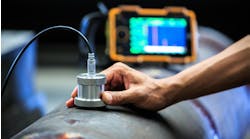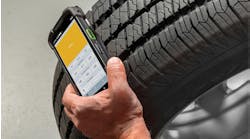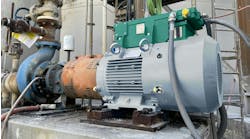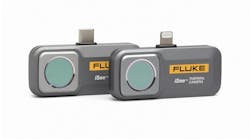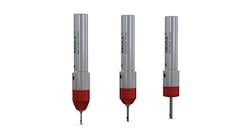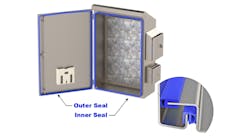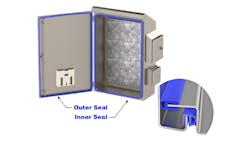Field Replaceable Gaskets Provide Lowest Cost for Electrical Enclosures
Electrical enclosures must be designed to protect sensitive equipment from the environment. Whether built for food & dairy, pharmaceutical, oil & gas, wastewater, or meat & poultry, the electrical enclosure is the first line of defense for protecting against harsh environments.
Washdown processes in food plants are among the most stringent requirements to be endured, and they can cause extreme water damage to the enclosure door gaskets, leading to costly repairs, replacement, and production downtime. At one large turkey packaging plant, automation engineers found that replacing enclosures that used current industry-standard pour-in-place or foam-in-place door gaskets with those featuring more robust field replaceable enclosure door gaskets considerably lowers the long-term overall cost of ownership.
Electrical Enclosures Explained
Electrical enclosures are rated in accordance with the purpose they serve. Generally, they must meet two standards: National Electrical Manufacturers Association (NEMA) ratings and ingress protection (IP) ratings, defined by the International Electrotechnical Commission (IEC).
NEMA ratings refer to protection against environmental hazards such as water, dust, oil or coolant or atmospheres containing corrosive agents such as acetylene or gasoline. Ranging from NEMA 1 to NEMA 13, enclosures are designed to meet specific weather and/or process conditions.
For example, a NEMA 4 is an enclosure built for the wash-down environment found in food plants and is typically the minimum requirement for processing plants. The NEMA 4 – High-Flow/Low-Pressure water test is performed at 65 gpm thru a 1-in. orifice at a distance of 10 ft using room temperature water.
IP ratings classify the degree of protection against intrusion, dust, accidental contact, and water. The IP rating is typically expressed with a 2-digit number. The first digit represents solid particle (dust) protection, and the second digit indicates the level of protection provided against harmful ingress of water.
IP ratings for general food & dairy processing typically require the first digit to be a 6, representing dust-tight protection. The second digit for food processing is typically a 6 (IP 66). This IPX6 test is another High-Flow/Low-Pressure water test performed at 26 gpm thru a 1/2-in. nozzle at a distance of 9 ft using room temperature water. The water test for IP X6 is not quite as robust as the NEMA 4 test; the U.S. food industry minimum is 4X, where 4 is washdown test and X is the corrosive resistance material.
9K (IP 69K), which protects the equipment from powerful high-pressure and high-temperature jets of water and chemicals, is a test performed using a spray wand, similar to what is found at a manual car wash.
This low-flow/high-pressure test is performed at 4 GPM through a spray wand between 1160 and 1450 psi, at a minimum temperature of 176°F and a distance as close as 4-in. from the enclosure. The IPX9K simulates a more realistic test that electrical enclosures will encounter in the meat & poultry industry.
The combination of high-temperature water at high pressure helps to quickly melt and remove the fat and meat particles that have accumulated in the equipment during production.
Washdown Process Affects Electrical Enclosure Door Gasket
The environmental conditions caused by the powerful spraying of hot water and chemicals as part of the washdown process can have a devastating effect on the life of an electrical enclosure door gasket. This is especially true of those installed with the “pour-in-place” method. The inexpensive pour-in-place (also known as foam-in-place) material is installed by a machine and is the less expensive method available for enclosure manufacturers. The majority of the electrical enclosure industry moved to this gasket method about 20 years ago.
Over time (as soon as 6 months depending upon environmental conditions), this type of gasket tends to absorb water, crack, and then fall off. The worse the conditions, the faster the cracking, which results in water getting into the enclosure and damaging or degrading sensitive electrical or high-tech electronic equipment. Unfortunately, one cannot simply send the door away for a replacement gasket because an electrical enclosure cannot be left without a door. And a completely new replacement door may end up costing about half that of the entire enclosure.
In addition, the pour-in-place gasket is molded to a specific door size, requiring owners to maintain many different-sized doors.
Another option is the field replaceable gasket system, for example, that is used in Custom Stainless Enclosures’ (CSE’s) 4Xxtreme Enclosures, which contains a double seal technology that is impenetrable to water. Designed for extreme indoor and outdoor locations, this enclosure was designed specifically for the worst of the worst conditions found in the Meat & Poultry industry. These enclosures are made with an easy-to-install push-on field replaceable gasket system that can be used on all enclosure sizes.
Turkey Packaging Plant Switches to “Double Seal” Field Replaceable Door Gasket Enclosures for Lower Cost
The meat packaging industry requires a washdown process that uses chemicals that tend to be harsh on standard components, including electrical enclosures. According to David Benes, President of Freemont Automation, that harshness led to dire consequences for a turkey processing plant that had originally used electrical enclosures with pour-in-place gaskets. He found that the Type: 4X electrical rating specified by the customer did not match the actual IP69K conditions his equipment would be installed in.
Benes specializes in food industry automation equipment projects. The firm develops the automation concepts, designs them, draws up the plans and assembles the equipment, and then integrates the system with electronics, computers, and switches. As part of the job, they had installed twelve Type: 4X stainless steel electrical enclosures purchased from a top manufacturer for three machines that run two shifts a day, 5 days a week, and go through an extreme washdown process.
“We installed the electrical enclosures and they looked great—clean and shiny,” says Benes. “Then we were asked to return after just a few years to evaluate and update the equipment. When we went back, we were shocked to find that the electrical boxes were filled with water, which had collected inside and was ruining all the electronics on the expensive equipment designed to insert the popup timer and put the turkey in a bag.”
Asked to provide suggestions on how to update and rebuild the equipment, Benes investigated further. He noticed one electrical enclosure elsewhere in the plant that had sustained no water damage, even though it went through the same washdown process. After determining that the functioning box was manufactured by CSE, Benes contacted the company and eventually ordered custom replacement 4Xxtreme IP69K Electrical Enclosures. These enclosures feature a patented double seal technology designed for extreme indoor and outdoor locations along with a single closing point (quarter turn or 3-point handle) for every enclosure they manufacture.
Benes explains that these enclosures may be more expensive to begin with, but the actual long-term total cost of ownership—which includes the initial cost of the equipment, plus installation and start-up, normal wear and tear maintenance, and production downtime over the 10 to 15-year equipment life—is far lower. Plus, CSE will guarantee that their 4Xxtreme Electrical Enclosures will provide the lowest cost of ownership than any other electrical enclosure on the market today.
In this case, the cost to repair just one of the machines was estimated at $42,500 for a total of $127,500 to rebuild all three machines. What it all comes down to is that if the turkey factory had specified the 4Xxtreme Enclosures, they would have initially paid about $1,500 more per machine, for a total of $4,500, but instead had to pay more than $127,500 in additional costs to replace the machines only 3 years after they were installed. This would be in addition to the non-equipment costs, including plant downtime (hours/days down); maintenance costs (materials & labor), and any other items in the list of what goes into the total cost of ownership.
Benes notes that he routinely goes into plants and finds that the pour-in-place door gaskets deteriorate after just two to four years in service. Maintenance personnel may be able to go in and install a glue substance to get some temporary protection, but the field replaceable gaskets provide complete protection with a simple maintenance job that takes just a few minutes. He now only installs 4Xxtreme electrical enclosures with field-replaceable gaskets and suggests to others that they should make them part of a standard build. He also noted that the electrician at the plant has said that he greatly prefers the new boxes. While the other boxes required frequent (even weekly) switch replacement, the CSE boxes so far have not required any maintenance.
“The competitor’s box might be cheaper initially, but we now specify only the CSE 4Xxtreme field replaceable gasket box because of our direct experience with how much time and money our customers will ultimately save on the electronics in the long run. We feel we won’t have to work on the machine as much because of water damage. We want our machines to last. We don’t try to find the cheapest—we find the best. It puts our mind at ease because we know we can brag about our equipment because it is simply the best!”
He adds, “The experience taught me that a true washdown box may have a higher initial cost but it is actually the cheapest option because it ultimately saves thousands of dollars of electronics. Also, these boxes are custom-made. With the big companies, you buy what they sell, but these boxes do not cost much more and we’re getting boxes that fit our machines instead of machines having to fit that box.”
